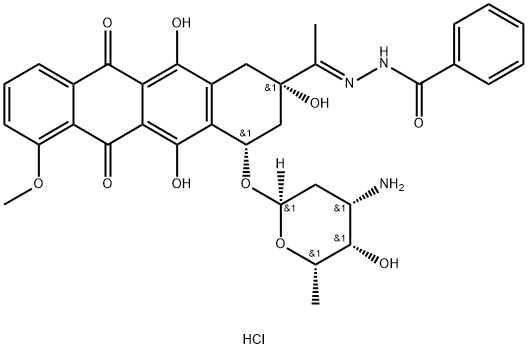Manufacturing Process
9.024 g daunorubicin-hydrochloride (its preparation and physicochemical
properties have been described in British Patent Specification No 985 598)
was dissolved in 800 ml ethanol and mixed with 2.5 ml acetic acid and 2.162
g benzoyl hydrazide and heated for 24 hours at 60°C. On cooling the obtained
precipitate was filtered off, washed with 100 ml of ethanol and dried in
vacuum at 20°C. It was dissolved in water and small quantity of insoluble
product was filtered off, the filtrate was lyophilized. (1-(4-((3-Amino-2,3,6-
trideoxy-α,L-lyxohexopyranosyl)oxy)-1,2,3,4,6,11-hexahydro-2,5,12-
trihydroxy-7-methoxy-6,11-dioxo-2-naphthacenyl)ethylidene)hydrazide
dihydrochloride (zorubicin) was obtained as red-orange crystalline powder;
[α] D 20 = -50° (c=0.2 in water). The compound may be employed in the form
of different non-toxic salts such as benzoates, fumarates, maleates, tartrates
and so on. The best among these compounds proves to be daunorubicin
benzoylhydrazone (rubidazone), which is less cardiotoxic (French Pat. No.
1,578,722 published in 1967, Class CO7d).
